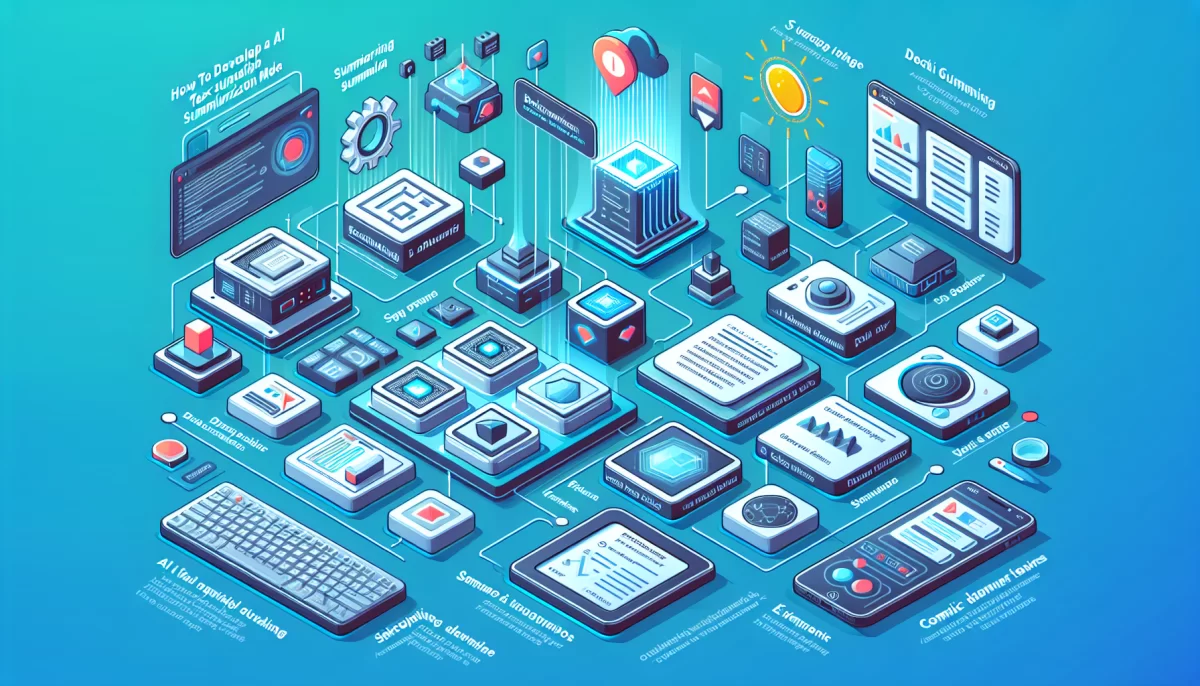How to Develop an AI Text Summarization Model: A Developer’s Guide
Artificial intelligence (AI) text summarization tools have become essential across various fields by condensing lengthy materials—ranging from blogs and research papers to essays—into concise, meaningful summaries. These tools preserve the original content’s intent and quality, enabling users like students, educators, writers, and marketers to save time and stay informed efficiently.
For developers interested in creating such AI-driven summarizers, understanding the nuanced techniques and technologies involved is paramount. This comprehensive guide presents a clear, step-by-step approach to building an AI text summarization model using state-of-the-art natural language processing (NLP) and deep learning technologies.
Key Skills Required for Developing an AI Text Summarization Model
Before diving into the development process, it’s important to ensure you have proficiency in the following areas:
- Natural Language Processing (NLP): Understanding language structure and semantics is critical. NLP enables machines to comprehend the context and meaning behind text.
- Python Programming: Python is the leading language for AI development, favored for its readability and vast ecosystem of AI and machine learning libraries.
- Deep Learning Frameworks: Familiarity with frameworks such as TensorFlow and PyTorch is essential for building and training neural network models.
- Dataset Management: Skills in collecting, cleaning, and preprocessing large textual datasets are vital to train effective models.
Step-by-Step Process to Develop an AI Text Summarization Model
1. Choose a Summarization Approach
AI summarizers typically use one of two fundamental methods:
- Abstractive Summarization: Generates novel phrases to summarize content, rephrasing concepts in an original way, similar to how humans summarize.
- Extractive Summarization: Selects and concatenates important sentences or phrases verbatim from the source text.
While extractive methods are simpler and sometimes faster, abstractive approaches offer more flexible, human-like summaries but require advanced model architectures and training. This guide focuses on developing an abstractive summarization model.
2. Set Up Your Development Environment and Libraries
Installing the right libraries is crucial for building your model efficiently. Key packages include:
- Transformers: Offers pre-trained state-of-the-art models like BART and BERT for NLP tasks.
- NLTK (Natural Language Toolkit): Provides utilities for text tokenization, cleaning, and stop word removal.
- FastAPI: Enables building fast APIs to serve your model after development.
- ROUGE Metric: Used for quantitative evaluation of summary quality.
Installation via pip:
pip install transformers datasets nltk fastapi rouge-score3. Collect and Prepare Your Dataset
The backbone of any AI text summarization model is robust, well-labeled data. The CNN/Daily Mail dataset is a popular choice containing news articles and their human-written summaries. Additionally, datasets like XSum and Gigaword have been widely utilized.
Gathering diverse datasets improves your model’s coverage and effectiveness across domains. Ensure data is cleaned carefully, removing noise without losing context.
4. Import and Preprocess Data Effectively
Preprocessing tasks include tokenization, stop word removal, and lemmatization to make data suitable for training. Here’s a Python snippet demonstrating preprocessing using NLTK:
import nltk
from nltk.tokenize import word_tokenize
from nltk.corpus import stopwords
from nltk.stem import WordNetLemmatizer
nltk.download('punkt')
nltk.download('stopwords')
nltk.download('wordnet')
text = "Your input text here."
tokens = word_tokenize(text)
stop_words = set(stopwords.words('english'))
filtered_tokens = [w for w in tokens if w.lower() not in stop_words]
lemmatizer = WordNetLemmatizer()
lemmatized_tokens = [lemmatizer.lemmatize(t) for t in filtered_tokens]
print('Processed Tokens:', lemmatized_tokens)5. Select and Configure Your Model Architecture
Transformer-based models like BART and T5 excel in abstractive summarization due to their ability to understand long-range dependencies and maintain contextual integrity.
The BART-large-CNN model, open-sourced by Facebook AI, is particularly effective and fine-tuned for summarization tasks. You can load a summarization pipeline pre-trained on BART easily:
from transformers import pipeline
summarizer = pipeline('summarization', model='facebook/bart-large-cnn')
text = "Your lengthy input text here."
summary = summarizer(text, max_length=130, min_length=30, do_sample=False)
print("Summary:", summary[0]['summary_text'])6. Train Your Model with Careful Optimization
Training involves fine-tuning pre-trained models like BART on your chosen dataset. The quality of training impacts summary coherence and relevance.
Essential considerations include:
- Configuring appropriate learning rates and batch sizes.
- Using loss functions such as cross-entropy to measure prediction accuracy.
- Evaluating model checkpoints regularly to avoid overfitting.
Example training snippet using Hugging Face Trainer:
from transformers import BartForConditionalGeneration, BartTokenizer, Trainer, TrainingArguments
from datasets import load_dataset
dataset = load_dataset('cnn_dailymail', '3.0.0')
model = BartForConditionalGeneration.from_pretrained('facebook/bart-large-cnn')
tokenizer = BartTokenizer.from_pretrained('facebook/bart-large-cnn')
def preprocess_function(examples):
inputs = examples['article']
model_inputs = tokenizer(inputs, max_length=1024, truncation=True)
with tokenizer.as_target_tokenizer():
labels = tokenizer(examples['highlights'], max_length=128, truncation=True)
model_inputs['labels'] = labels['input_ids']
return model_inputs
tokenized_datasets = dataset.map(preprocess_function, batched=True)
training_args = TrainingArguments(
output_dir='./results',
evaluation_strategy='epoch',
learning_rate=2e-5,
per_device_train_batch_size=4,
num_train_epochs=3,
weight_decay=0.01,
save_total_limit=2,
)
trainer = Trainer(
model=model,
args=training_args,
train_dataset=tokenized_datasets['train'],
eval_dataset=tokenized_datasets['validation'],
)
trainer.train()7. Implement and Integrate the Model
After training, utilize frameworks like TensorFlow or PyTorch for inference. Combining tokenizers and models facilitates summary generation as shown:
from transformers import BartTokenizer, BartForConditionalGeneration
tokenizer = BartTokenizer.from_pretrained('facebook/bart-large-cnn')
model = BartForConditionalGeneration.from_pretrained('facebook/bart-large-cnn')
text = "Input your text here."
inputs = tokenizer.encode('summarize: ' + text, return_tensors='pt', max_length=512, truncation=True)
summary_ids = model.generate(
inputs, max_length=50, min_length=25, length_penalty=2.0, num_beams=4, early_stopping=True)
summary = tokenizer.decode(summary_ids[0], skip_special_tokens=True)
print('Summary:', summary)8. Evaluate Model Performance Using ROUGE Metrics
Measuring your model’s output quality is essential. The ROUGE (Recall-Oriented Understudy for Gisting Evaluation) metric assesses how well generated summaries overlap with reference summaries in terms of recall, precision, and F1-score.
from datasets import load_metric
rouge = load_metric('rouge')
generated_summary = "Generated summary text here."
reference_summary = "Reference summary text here."
scores = rouge.compute(predictions=[generated_summary], references=[reference_summary])
print('ROUGE Scores:', scores)Typical ROUGE-1 and ROUGE-L F1 scores above 0.4 are indicative of good summarization quality, depending on dataset complexity.
9. Deployment Considerations
For production use, wrap your model within APIs using frameworks like FastAPI or Flask, enabling easy integration into web or mobile apps. Tools like NVIDIA Triton Inference Server further support scalable deployment. Ensure efficient GPU or cloud resources to handle real-time summarization requests seamlessly.
Real-World Example: AI-Powered Text Summarization Applications
Many AI summarization tools harness the power of transformer models to deliver fast, accurate text condensation. For instance, Summarizer.org uses NLP and deep learning techniques to perform abstractive summarization with high precision and speed, proving the feasibility of these technologies in practical scenarios.
Conclusion: Embracing AI for Efficient Text Summarization
AI-based text summarization continues to evolve rapidly, benefiting from advances in NLP and transformer architectures. Developers equipped with Python proficiency, a solid understanding of NLP, and deep learning frameworks can build powerful summarization systems to simplify content consumption globally.
By following the structured approach outlined above, and utilizing publicly available datasets and pre-trained transformer models, you can create summarization tools that effectively synthesize information across domains.
Summary of Development Steps:
- Select summarization approach (abstractive or extractive).
- Setup environment and import key libraries.
- Collect and preprocess textual datasets.
- Choose and configure transformer-based model architecture.
- Train and fine-tune the model optimizing hyperparameters.
- Evaluate performance using ROUGE or similar metrics.
- Deploy the model via APIs for integration.
Continued innovation and research in large language models (LLMs) promise even more sophisticated summarization capabilities. For instance, OpenAI’s GPT-4 has demonstrated impressive summarization performance across multiple languages and formats, illustrating the future direction of this space (OpenAI, 2024).
With the right foundation, developers can contribute to creating AI tools that empower users by making large volumes of text more accessible and digestible.
References:
- See et al. (2017). Get To The Point: Summarization with Pointer-Generator Networks. arXiv:1704.04368
- Lewis et al. (2020). BART: Denoising Sequence-to-Sequence Pre-training for Natural Language Generation. arXiv:1910.13461
- Lin, Chin-Yew. (2004). ROUGE: A Package for Automatic Evaluation of Summaries. In Text Summarization Branches Out, ACL 2004
- OpenAI GPT-4 Technical Report (2024). https://openai.com/research/gpt-4



